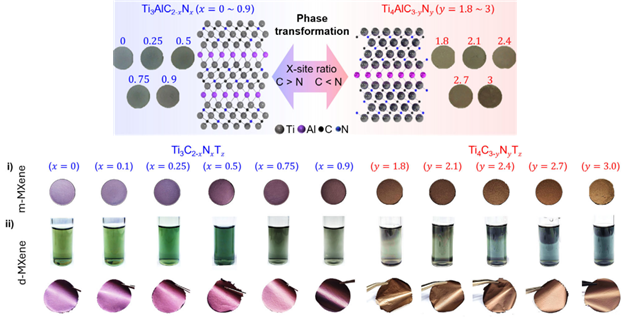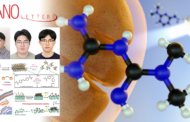A research team, jointly led by Professor Soon-Yong Kwon from the Graduate School of Semiconductor Materials and Devices Engineering, and Professors EunMi Choi and Gangil Byun from the Department of Electrical Engineering at UNIST, in collaboration with Professor Gun-Do Lee at Seoul National University, announced the successful synthesis of high-purity, tunable nitrogen (N)-substituted MAX precursors and the resultant MXene two-dimensional (2D) materials — a first in the world.
MXenes are a class of 2D nanomaterials, composed of alternating metal and carbon layers, renowned for their exceptional electrical conductivity and versatile chemical design potential, earning them the label of “dream materials” for future applications. Notably, MXenes have garnered attention as ultrathin, lightweight electromagnetic interference (EMI) shielding materials capable of blocking signals in the sub-terahertz (sub-THz) range. Unlike traditional metallic shields, which are heavy, prone to corrosion, and exhibit performance degradation at high frequencies, MXenes offer superior high-frequency shielding while maintaining minimal thickness and weight.
 Figure 1. (Top) Schematic illustration and photographs of cold-pressed pellets of XSS MAX phases. (Bottom) Photograph of synthesized XSS MXenes showing: i) cold-pressed multi-layered MXene (m-MXene), ii) delaminated MXene (d-MXene) solution (top) with a vacuum-filtrated free-standing film (bottom).
Figure 1. (Top) Schematic illustration and photographs of cold-pressed pellets of XSS MAX phases. (Bottom) Photograph of synthesized XSS MXenes showing: i) cold-pressed multi-layered MXene (m-MXene), ii) delaminated MXene (d-MXene) solution (top) with a vacuum-filtrated free-standing film (bottom).
Until now, most MXenes have been based on carbon (C). However, theoretical predictions suggested that substituting N for C atoms could further enhance their physical and chemical properties. Challenges in synthesis prevented realization—until this collaborative effort, which successfully replaced portions of the carbon in MAX precursors with N, developed a novel titanium-based MAX precursor process, and produced MXene with record-high performance.
Remarkably, the N-substituted MXene films, with a thickness only one-tenth that of a human hair (approximately 5–10 micrometers), demonstrate an electrical conductivity of 35,000 S/cm — the highest reported among MXene materials to date. This translates to exceptional EMI shielding capabilities.
The new process allows precise control over the degree of N substitution from 0% to nearly 100%, while maintaining a single-crystal structure free of impurities. This tunability enables the fine adjustment of MXene’s electromagnetic properties, optimizing electromagnetic wave reflection and absorption for various applications.
Professor Kwon stated, “N-substituted MXenes represent a groundbreaking advancement in next-generation electromagnetic shielding technology. They have the potential to significantly reduce electromagnetic interference across a wide range of fields—from mobile devices and automotive or aerospace electronic systems to advanced communication infrastructure.”
This research was supported by the Nano Material Technology Development Program through the National Research Foundation (NRF) of Korea, funded by the Ministry of Science and ICT (MSIT). The findings were published in the renowned journal Advanced Materials on April 25, 2025.
Journal Reference
Ju-Hyoung Han, Jaeeun Park, Mincheal Kim, et al., “Ultrahigh Conductive MXene Films for Broadband Electromagnetic Interference Shielding,” Adv. Mater., (2025).













